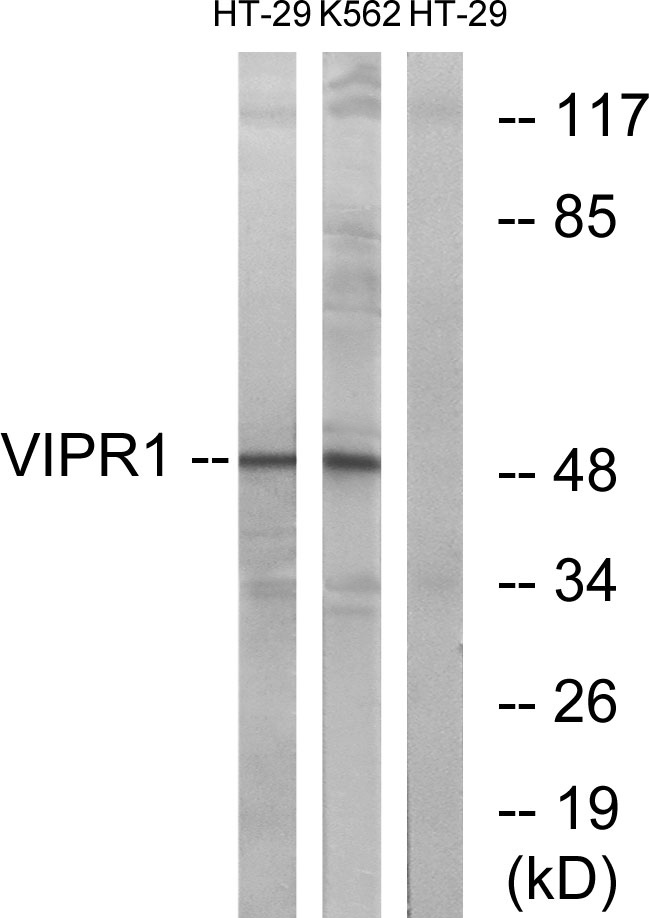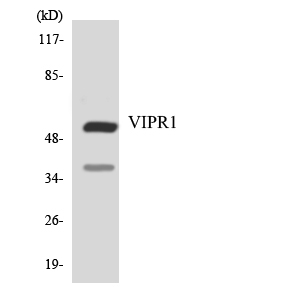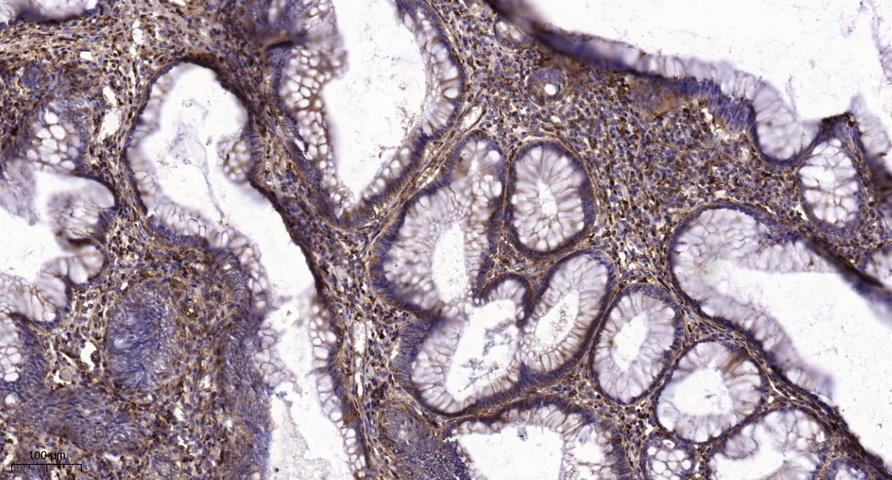VPAC1 Polyclonal Antibody
- Catalog No.:YT4887
- Applications:WB;IHC;IF;ELISA
- Reactivity:Human;Mouse;Rat
- Target:
- VPAC1
- Fields:
- >>Neuroactive ligand-receptor interaction
- Gene Name:
- VIPR1
- Protein Name:
- Vasoactive intestinal polypeptide receptor 1
- Human Gene Id:
- 7433
- Human Swiss Prot No:
- P32241
- Mouse Gene Id:
- 22354
- Mouse Swiss Prot No:
- P97751
- Rat Gene Id:
- 24875
- Rat Swiss Prot No:
- P30083
- Immunogen:
- The antiserum was produced against synthesized peptide derived from human VIPR1. AA range:332-381
- Specificity:
- VPAC1 Polyclonal Antibody detects endogenous levels of VPAC1 protein.
- Formulation:
- Liquid in PBS containing 50% glycerol, 0.5% BSA and 0.02% sodium azide.
- Source:
- Polyclonal, Rabbit,IgG
- Dilution:
- WB 1:500 - 1:2000. IHC 1:100 - 1:300. IF 1:200 - 1:1000. ELISA: 1:10000. Not yet tested in other applications.
- Purification:
- The antibody was affinity-purified from rabbit antiserum by affinity-chromatography using epitope-specific immunogen.
- Concentration:
- 1 mg/ml
- Storage Stability:
- -15°C to -25°C/1 year(Do not lower than -25°C)
- Other Name:
- VIPR1;Vasoactive intestinal polypeptide receptor 1;VIP-R-1;Pituitary adenylate cyclase-activating polypeptide type II receptor;PACAP type II receptor;PACAP-R-2;PACAP-R2;VPAC1
- Observed Band(KD):
- 52kD
- Background:
- vasoactive intestinal peptide receptor 1(VIPR1) Homo sapiens This gene encodes a receptor for vasoactive intestinal peptide, a small neuropeptide. Vasoactive intestinal peptide is involved in smooth muscle relaxation, exocrine and endocrine secretion, and water and ion flux in lung and intestinal epithelia. Its actions are effected through integral membrane receptors associated with a guanine nucleotide binding protein which activates adenylate cyclase. Several transcript variants encoding different isoforms have been found for this gene. [provided by RefSeq, Oct 2011],
- Function:
- function:This is a receptor for VIP. The activity of this receptor is mediated by G proteins which activate adenylyl cyclase. The affinity is VIP = PACAP-27 > PACAP-38.,similarity:Belongs to the G-protein coupled receptor 2 family.,tissue specificity:In lung, HT29 colonic epithelial cells, Raji B-lymphoblasts. Lesser extent in brain, heart, kidney, liver and placenta. Not expressed in CD4+ or CD8+ T-cells. Expressed in the T-cell lines HARRIS, HuT 78, Jurkat and Tsup-1, but not in the T-cell lines PEER, MOLT-4, HSB and YT.,
- Subcellular Location:
- Cell membrane; Multi-pass membrane protein.
- Expression:
- In lung, HT-29 colonic epithelial cells, Raji B-lymphoblasts. Lesser extent in brain, heart, kidney, liver and placenta. Not expressed in CD4+ or CD8+ T-cells. Expressed in the T-cell lines HARRIS, HuT 78, Jurkat and SUP-T1, but not in the T-cell lines Peer, MOLT-4, HSB and YT.
Sympathetic Neurotransmitter, VIP, Delays Intervertebral Disc Degeneration via FGF18/FGFR2-Mediated Activation of Akt Signaling Pathway Advanced Biology Kaiqiang Sun IHC,IF Human nucleus pulposus (NP) tissue nucleus pulposus (NP) cell
- June 19-2018
- WESTERN IMMUNOBLOTTING PROTOCOL
- June 19-2018
- IMMUNOHISTOCHEMISTRY-PARAFFIN PROTOCOL
- June 19-2018
- IMMUNOFLUORESCENCE PROTOCOL
- September 08-2020
- FLOW-CYTOMEYRT-PROTOCOL
- May 20-2022
- Cell-Based ELISA│解您多样本WB检测之困扰
- July 13-2018
- CELL-BASED-ELISA-PROTOCOL-FOR-ACETYL-PROTEIN
- July 13-2018
- CELL-BASED-ELISA-PROTOCOL-FOR-PHOSPHO-PROTEIN
- July 13-2018
- Antibody-FAQs
- Products Images

- Immunofluorescence analysis of MCF7 cells, using VIPR1 Antibody. The picture on the right is blocked with the synthesized peptide.

- Western blot analysis of lysates from HT-29 and K562 cells, using VIPR1 Antibody. The lane on the right is blocked with the synthesized peptide.

- Western blot analysis of the lysates from HeLa cells using VIPR1 antibody.

- Immunohistochemical analysis of paraffin-embedded human colon cancer. 1, Tris-EDTA,pH9.0 was used for antigen retrieval. 2 Antibody was diluted at 1:200(4° overnight.3,Secondary antibody was diluted at 1:200(room temperature, 45min).


